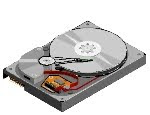
Yeah its true now you can remove bad sectors from your hard disk and get your lost data and partially dead hard disks back to life..
Well the procedure is very simple and easy to use.
Firstly you should have a CD writer in your system. and you also need a recordable empty CD.
Now you need to download the image file of a software which is named as Spinrite.
The image file will be in .iso format and you can write it on the CD by using any CD recording tool like Nero, Power ISO etc…
When you are done writing the CD restart you pc and boot your system from cd because this is such a software which works in DOS mode so that the hard disk is not being used by any other program or windows..
The software will then examine your hard drive and ask you for the partitions you want to check.. choose the partition you think which have bad sectors and the data in them is unreadable or they work really slow..
Then select the type of repairing you want to do to your hard drive among the five options choose the last one to get the best results..
This software will take its time which could vary from several hours to days depending upon the size and health of the disk but i can assure you that this software will do your work…and repair the partially damaged part of the hard disk..
It will also check all the sectors of that partition for read write errors and fix them and discover the hidden bad sectors and give you hard drive a new life..
Hurray now your lost data is back but make sure to transfer it to some where else before the hard drive dies completely
Thanks for Reading and Dont forget to post your comments after trying the method and I am pretty sure you will not be disappointed..
Read More..





